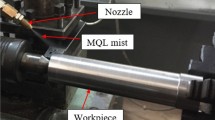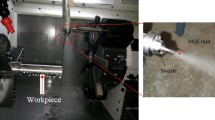Abstract
Nowadays, the surface texture of tool is an attractive machining technique due to the benefits in any chip removal machining process performance. However, surface texture design on texture tool plays a significant role in improving the turning process performance, in this context, a novel hybrid surface texture design has been proposed in the current work. The present work focused on the machinability improvement of AISI 304 material by employing the surface texture tool under minimum quantity lubrication (MQL) condition. In this work, comparative evaluation of turning performance has been carried out with a fabricated single texture tool which consists of circular pit holes pattern (T-1) and a fabricated novel hybrid texture tool combination of linear grooves and circular dimples (T-2), respectively, during machining of AISI 304 material at increasing cutting velocity condition. From the result, it was observed that the proposed hybrid texture tool (T-2) significantly reduced the cutting temperature (Tm), tool flank wear (Vb) and surface roughness (Ra) to a maximum of 26%, 31% and 34%, respectively, when compared to T-1. Further, low built-up edge (BUE) was found in T-2 tool over T-1, respectively.








Similar content being viewed by others
References
Pereira O, Rodríguez A, Fernández-Abia AI, Barreiro J, de Lacalle LL (2016) Cryogenic and minimum quantity lubrication for an eco-efficiency turning of AISI 304. J Clean Prod 139:440–449
Pang M, Nie Y, Ma L (2018) Effect of symmetrical conical micro-grooved texture on tool–chip friction property of WC–TiC/Co cemented carbide tools. Int J Adv Manuf Technol 99(1–4):737–746
Wei Y, Kim MR, Lee DW, Park C, Park SS (2017) Effects of micro textured sapphire tool regarding cutting forces in turning operations. Int J Precis Eng Manuf Green Technol 4(2):141–147
Liu Y, Deng J, Wu F, Duan R, Zhang X, Hou Y (2017) Wear resistance of carbide tools with textured flank-face in dry cutting of green alumina ceramics. Wear 372:91–103
Arulkirubakaran D, Senthilkumar V, Kumawat V (2016) Effect of micro-textured tools on machining of Ti–6Al–4V alloy: an experimental and numerical approach. Int J Refract Metals Hard Mater 54:165–177
Mishra SK, Ghosh S, Aravindan S (2018) Characterization and machining performance of laser-textured chevron shaped tools coated with AlTiN and AlCrN coatings. Surf Coat Technol 334:344–356
Jesudass Thomas S, Kalaichelvan K (2018) Comparative study of the effect of surface texturing on cutting tool in dry cutting. Mater Manuf Process 33(6):683–694
Sivaiah P, Chakradhar D (2019) The effectiveness of a novel cryogenic cooling approach on turning performance characteristics during machining of 17-4 PH stainless steel material. Silicon 11(1):25–38
Sivaiah P, Chakradhar D (2018) Analysis and modeling of cryogenic turning operation using response surface methodology. Silicon 10(6):2751–2768
Sivaiah Potta (2019) Effect of cryogenic coolant on turning performance: a comparative study. SN Appl Sci 1(1):67
Sivaiah P, Chakradhar D (2019) Performance improvement of cryogenic turning process during machining of 17-4 PH stainless steel using multi objective optimization techniques. Measurement 136:326–336
Sivaiah P, Chakradhar D (2018) Effect of cryogenic coolant on turning performance characteristics during machining of 17-4 PH stainless steel: a comparison with MQL, wet, dry machining. CIRP J Manuf Sci Technol 21:86–96
Sivaiah P, Chakradhar D (2019) Modeling and optimization of sustainable manufacturing process in machining of 17-4 PH stainless steel. Measurement 134:142–152
Sivaiah P, Chakradhar D (2018) Comparative evaluations of machining performance during turning of 17-4 PH stainless steel under cryogenic and wet machining conditions. Mach Sci Technol 22(1):147–162
Sivaiah P, Chakradhar D (2016) Influence of cryogenic coolant on turning performance characteristics: a comparison with wet machining. Mater Manuf Process 32(13):1475–1485
Sivaiah P, Chakradhar D (2017) Machinability studies on 17-4 PH stainless steel under cryogenic cooling environment. Mater Manuf Process 32(15):1775–1788
Sivaiah P, Chakradhar D (2018) Multi performance characteristics optimization in cryogenic turning of 17-4 PH stainless steel using Taguchi coupled grey relational analysis. Adv Mater Process Technol 4(3):431–447
Dinesh S, Senthilkumar V, Asokan P (2017) Experimental studies on the cryogenic machining of biodegradable ZK60 Mg alloy using micro-textured tools. Mater Manuf Process 32(9):979–987
Palanisamy D, Balasubramanian K, Manikandan N, Arulkirubakaran D, Ramesh R (2019) Machinability analysis of high strength materials with cryo-treated textured tungsten carbide inserts. Mater Manuf Process 34(5):502–510
Manikandan N, Arulkirubakaran D, Palanisamy D, Raju R (2019) Influence of wire-EDM textured conventional tungsten carbide inserts in machining of aerospace materials (Ti–6Al–4V alloy). Mater Manuf Process 34(1):103–111
Sharma V, Pandey PM (2016) Comparative study of turning of 4340 hardened steel with hybrid textured self-lubricating cutting inserts. Mater Manuf Process 31(14):1904–1916
Sun J, Zhou Y, Deng J, Zhao J (2016) Effect of hybrid texture combining micro-pits and micro-grooves on cutting performance of WC/Co-based tools. Int J Adv Manuf Technol 86(9–12):3383–3394
Orra K, Choudhury SK (2018) Tribological aspects of various geometrically shaped micro-textures on cutting insert to improve tool life in hard turning process. J Manuf Process 31:502–513
Xing Y, Deng J, Zhao J, Zhang G, Zhang K (2014) Cutting performance and wear mechanism of nanoscale and microscale textured Al2O3/TiC ceramic tools in dry cutting of hardened steel. Int J Refract Metals Hard Mater 43:46–58
Sivaiah P, Uma B (2019) Effect of surface texture tools and minimum quantity lubrication (MQL) on tool wear and surface roughness in CNC turning of AISI 52100 steel. J Inst Eng Ser C. https://doi.org/10.1007/s40032-019-00512-2
Hao X, Chen X, Xiao S, Li L, He N (2018) Cutting performance of carbide tools with hybrid texture. Int J Adv Manuf Technol 97(9–12):3547–3556
Author information
Authors and Affiliations
Corresponding author
Additional information
Technical Editor: Lincoln Cardoso Brandao.
Publisher's Note
Springer Nature remains neutral with regard to jurisdictional claims in published maps and institutional affiliations.
Rights and permissions
About this article
Cite this article
Sivaiah, P. Evaluation of hybrid textured tool performance under minimum quantity lubrication while turning of AISI 304 steel. J Braz. Soc. Mech. Sci. Eng. 41, 571 (2019). https://doi.org/10.1007/s40430-019-2069-0
Received:
Accepted:
Published:
DOI: https://doi.org/10.1007/s40430-019-2069-0




